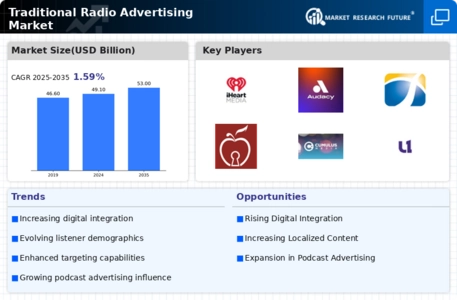Market Growth Projections
The Global Traditional Radio Advertising Market Industry is poised for gradual growth, with projections indicating an increase from 49.1 USD Billion in 2024 to 53.0 USD Billion by 2035. This anticipated growth reflects the market's ability to adapt to changing consumer preferences and technological advancements. The compound annual growth rate of 0.69% from 2025 to 2035 suggests a steady, albeit modest, expansion. Factors contributing to this growth may include the continued integration of digital platforms and the enduring appeal of radio as a trusted source of information and entertainment. As the market evolves, it is likely to attract new advertisers seeking to leverage its unique advantages.
Steady Revenue Generation
The Global Traditional Radio Advertising Market Industry is projected to generate approximately 49.1 USD Billion in 2024, indicating a robust revenue stream. This consistent financial performance is attributed to the enduring popularity of radio as a medium for reaching diverse audiences. Advertisers leverage radio's broad reach to target specific demographics effectively, making it a preferred choice for local businesses and national brands alike. The ability to deliver messages in real-time enhances its appeal, as advertisers can respond swiftly to market trends. This steady revenue generation underscores the market's resilience and potential for sustained growth.
Cost-Effective Advertising Medium
The Global Traditional Radio Advertising Market Industry is characterized by its cost-effectiveness, making it an attractive option for businesses of all sizes. Compared to television and print media, radio advertising typically incurs lower production and placement costs. This affordability enables small and medium enterprises to access advertising opportunities that might otherwise be out of reach. As a result, radio serves as a vital platform for local businesses aiming to increase brand awareness without substantial financial investment. The cost-effective nature of radio advertising is likely to contribute to its sustained popularity and relevance in the advertising ecosystem.
Integration with Digital Platforms
The integration of traditional radio with digital platforms is reshaping the Global Traditional Radio Advertising Market Industry. Many radio stations now offer online streaming and mobile applications, expanding their reach beyond traditional airwaves. This convergence allows advertisers to engage with listeners across multiple channels, enhancing brand visibility. For instance, a campaign may utilize both radio spots and social media promotions, creating a cohesive marketing strategy. As the industry evolves, this integration is likely to attract a younger audience, further solidifying radio's relevance in a digital age. The potential for cross-platform advertising could drive growth in the coming years.
Targeted Advertising Opportunities
In the Global Traditional Radio Advertising Market Industry, targeted advertising emerges as a compelling driver. Radio stations often cater to specific demographics, allowing advertisers to tailor their messages to particular audience segments. For instance, a local station may focus on community events, attracting listeners who are more likely to engage with local businesses. This targeted approach not only enhances the effectiveness of advertising campaigns but also fosters a deeper connection between brands and consumers. As advertisers increasingly seek personalized marketing strategies, the ability of radio to deliver targeted content positions it as a valuable tool in the advertising landscape.
Resilience in Economic Fluctuations
The Global Traditional Radio Advertising Market Industry demonstrates resilience during economic fluctuations, which is a notable driver of its stability. Historically, radio advertising has maintained a steady presence even in challenging economic conditions, as businesses often turn to cost-effective advertising solutions. This trend suggests that radio remains a reliable medium for brands seeking to maintain visibility during downturns. Furthermore, the projected compound annual growth rate of 0.69% from 2025 to 2035 indicates a gradual recovery and potential growth trajectory. This resilience positions radio advertising as a dependable choice for advertisers navigating uncertain economic landscapes.



















